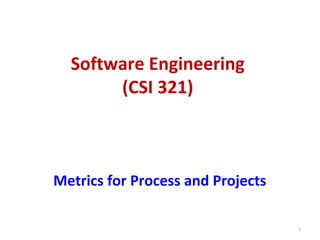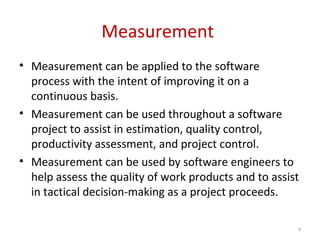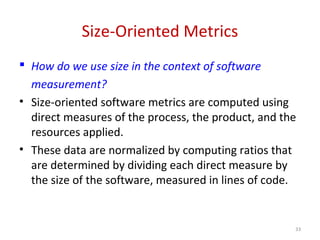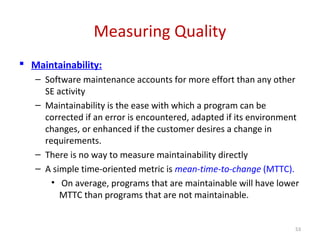The document discusses software process measurement and metrics. Some key points:
1. Measurement is fundamental to software engineering as it allows processes to be evaluated and improved continuously. Metrics can be used for estimation, quality control, productivity assessment, and project control.
2. Process metrics are collected across projects over long periods to provide indicators for long-term process improvements. Project metrics enable managers to assess status, track risks, and adjust tasks.
3. Guidelines for metrics include using common sense, providing feedback, not evaluating individuals, setting clear goals, and not threatening teams. Metrics should indicate problem areas for improvement, not be considered negative.

![Measurement
“You can’t control what you can’t measure”
[Tom
DeMarco]
2](https://image.slidesharecdn.com/lecture10-190719030944/85/Software-Engineering-Metrics-for-Process-and-Projects-2-320.jpg)









































![Computing Function Points
FP = WF x [0.65 + 0.01 x CAV]
44
Weighting Factor
Count Total
Constants
(Empirically
Determined)
Complexity
Adjustment
Value Total](https://image.slidesharecdn.com/lecture10-190719030944/85/Software-Engineering-Metrics-for-Process-and-Projects-44-320.jpg)









![Measuring Quality
Integrity:
– Assess threats, security of software.
– Measures a system’s ability to withstand attacks
to its security.
– To measure integrity, two additional attributes must be
defined: Threat & Security
• Threat = probability of attack (that causes failure)
• Security = probability that attack is repelled
• Integrity = Σ [1 - threat X (1 - security)]
54](https://image.slidesharecdn.com/lecture10-190719030944/85/Software-Engineering-Metrics-for-Process-and-Projects-54-320.jpg)








